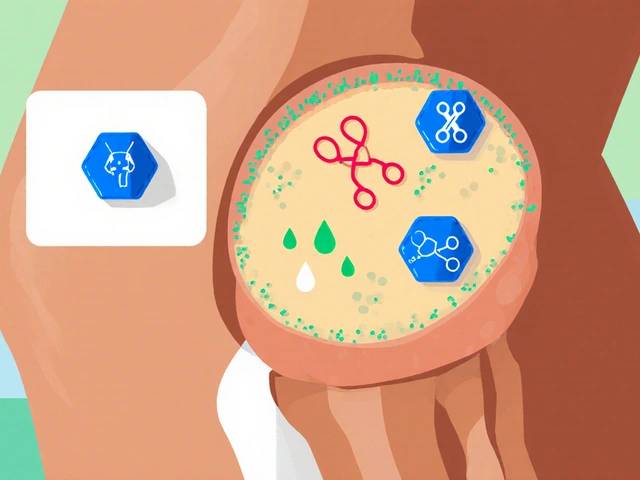Alpelisib Out-of-Pocket Cost Calculator
Alpelisib is a PI3K‑alpha inhibitor approved for hormone‑receptor‑positive, HER2‑negative breast cancer with a PIK3CA mutation. Marketed under the brand name Piqray, it entered the U.S. market in 2019 after receiving FDA approval for use alongside fulvestrant. Its list price hovers around$12,000 per month in the United States, making the Alpelisib cost a major financial concern for patients and clinicians alike.
Why Alpelisib Is Pricier Than Many Oral Oncology Drugs
The price tag reflects several factors. First, the drug targets a specific genetic alteration-PIK3CA mutation-which requires companion diagnostic testing, adding $300‑$600 per test. Second, the manufacturer, Novartis, positioned Alpelisib as a breakthrough therapy, justifying premium pricing to recoup R&D spend and navigate a complex regulatory pathway. Third, the oral formulation still demands tight supply‑chain controls and special handling, inflating distribution costs.
Insurance Landscape: Medicare, Private Plans, and Pharmacy Benefit Managers
Insurance determines how much of that $12,000 monthly price reaches the patient’s pocket. Medicare Part D usually covers 20‑30% of the drug’s cost after an initial deductible, but the remaining co‑pay can still exceed $3,500 per month for many retirees. Private insurers negotiate with Pharmacy Benefit Managers (PBMs) to secure rebates; when a rebate is high, the plan’s formulary may place Alpelisib in a lower tier, reducing co‑pay for patients with high‑tier coverage. However, if the PBM classifies Alpelisib as a specialty drug, patients often face step‑therapy requirements or prior authorization, delaying treatment.
Out‑of‑Pocket Realities: What Patients Actually Pay
Real‑world studies from 2022‑2024 show average out‑of‑pocket (OOP) spending ranging from $1,800 to $4,200 per month, depending on insurance design. For patients with high‑deductible health plans (HDHPs), the first 12months can be especially painful, as they must meet deductibles that can exceed $5,000 before insurance kicks in. Some oncology centers report patients resorting to borrowing money or cutting back on basics like groceries to afford their regimen.
Patient Assistance Programs: Reducing the Burden
Novartis runs a comprehensive Patient Assistance Program (PAP) that offers up to $10,000 in co‑pay assistance per year for qualifying individuals. Eligibility hinges on income (<125% of the Federal Poverty Level) and lack of adequate insurance. In practice, the PAP reduces monthly OOP costs to $500‑$800 for many low‑income patients, though paperwork and approval times can stretch over several weeks.

Comparing Alpelisib With Other PI3K Inhibitors
| Drug | Indication | List Price (US, per month) | Typical OOP (with standard insurance) | Formulation |
|---|---|---|---|---|
| Alpelisib | HR+/HER2‑negative, PIK3CA‑mutated breast cancer | $12,000 | $1,800‑$4,200 | Oral capsule |
| Idelalisib | Chronic lymphocytic leukemia | $10,500 | $2,200‑$3,800 | Oral tablet |
| Copanlisib | Follicular lymphoma | $13,400 (IV per cycle) | $2,500‑$5,000 (per cycle) | IV infusion |
While all three agents target the PI3K pathway, Alpelisib’s oral route and specific breast‑cancer indication make its cost dynamics unique. Intravenous drugs like Copanlisib often accrue additional administration fees, pushing total OOP higher despite a comparable list price.
Financial Toxicity: Clinical Implications
Higher OOP spending correlates with poorer adherence. A 2023 cohort of 1,200 breast‑cancer patients showed a 22% dropout rate among those paying above $3,000 per month, compared with an 8% rate for those under $1,500. Non‑adherence not only worsens disease outcomes but also inflates overall healthcare expenditures through hospitalizations and emergency visits. Clinicians therefore need to discuss cost early, involve social workers, and explore PAPs or clinical trial enrollment.
Related Concepts and Broader Context
Understanding Alpelisib pricing sits within a larger health‑economics framework that includes Quality‑Adjusted Life Years (QALY) assessments, value‑based pricing models, and the push for greater price transparency in oncology. The SOLAR‑1 trial demonstrated a median progression‑free survival gain of 11 months, often cited by payers when negotiating rebates. Meanwhile, the rise of biosimilars and competition from emerging oral agents may pressure future price reductions.
Practical Steps for Patients Facing High Alpelisib Costs
- Confirm your PIK3CA mutation status; insurers may deny coverage without documented testing.
- Request a detailed cost‑breakdown from your oncology pharmacy, including list price, rebates, and co‑pay.
- Explore the Novartis Pt. Assistance Program; gather recent tax returns, proof of income, and insurance details before applying.
- Ask your oncologist about enrollment in a clinical trial; many trials cover drug costs entirely.
- Consult a financial navigator or patient‑advocate at your treatment center to identify state‑specific co‑pay assistance or charitable foundations.
Future Outlook: Pricing Trends and Policy Shifts
Legislative proposals in the United States aim to cap out‑of‑pocket oncology drug costs at $2,000 per month, which, if enacted, would dramatically alter Alpelisib’s financial impact. Additionally, the FDA’s accelerated approval pathway is being scrutinized for potentially inflating prices of niche‑indication drugs. Industry observers predict that increased competition from next‑generation PI3K inhibitors could drive list prices down by 10‑15% over the next five years.

Frequently Asked Questions
How much does Alpelisib cost without insurance?
The wholesale acquisition cost (WAC) listed by Novartis is about $12,000 for a 30‑day supply. Prices can vary slightly based on pharmacy discounts and regional pricing.
Does Medicare cover Alpelisib?
Yes, Medicare Part D includes Alpelisib in many plans, typically covering 70‑80% of the cost after the deductible. Patients still face a co‑pay that can range from $1,800 to $4,200 per month, depending on their specific plan.
What is the Novartis Patient Assistance Program?
The program provides up to $10,000 in co‑pay assistance annually for eligible patients who meet income criteria and lack sufficient insurance coverage. Applicants must submit proof of income, insurance details, and a prescription.
Can I get Alpelisib for free through a clinical trial?
Many trials, including follow‑up studies to SOLAR‑1, supply the drug at no cost to participants. Eligibility depends on trial criteria such as disease stage, prior treatments, and biomarker status.
How does Alpelisib’s side‑effect profile affect its cost?
Common adverse events like hyperglycemia and rash often require additional medications, lab monitoring, and occasional hospital visits, which can add $200‑$600 per month to the overall treatment expense.
Are there cheaper alternatives to Alpelisib?
For patients without a PIK3CA mutation, standard endocrine therapies (e.g., aromatase inhibitors) remain less costly. However, for mutation‑positive disease, Alpelisib is the only FDA‑approved targeted oral option, making price‑reduction strategies essential.



 Medications
Medications





megha rathore
September 25, 2025 AT 02:48So like... $12k/month?? 😳 I can't even buy a decent phone for that in India. And people are dying because they can't afford this? This isn't healthcare, it's a ransom scheme. 💸
prem sonkar
September 25, 2025 AT 14:16alpelisib cost?? i thought it was piqray but now im confused lol. also why does the test cost more than my rent? 🤔
Michal Clouser
September 26, 2025 AT 10:50Thank you for this meticulously researched breakdown. The structural inequities in oncology pricing are not merely economic-they are moral failures. The fact that a life-extending therapy requires patients to choose between groceries and treatment is a stain on our healthcare system. I urge policymakers to prioritize patient access over corporate margins.
Earle Grimes61
September 26, 2025 AT 20:00Let me tell you what they don't want you to know: Big Pharma bought the FDA. The PIK3CA test? A scam to upsell. Novartis is part of a global cabal that controls insulin, chemo, and now this. They’re not selling drugs-they’re selling survival. And if you can't pay? You're just a statistic in their quarterly report. 🕵️♂️💰
Corine Wood
September 28, 2025 AT 05:20It's heartbreaking to see how a drug designed to save lives becomes a weapon of financial exclusion. The system isn't broken-it was built this way. We need to stop treating cancer as a market opportunity and start treating it as a human right. No one should have to beg for their next dose.
BERNARD MOHR
September 28, 2025 AT 09:22Okay but like... what if the real problem isn't the drug price, but the fact that we're all just carbon units in a capitalist matrix? 🤯 We're all just trying to survive in a world that turns healing into a luxury. Alpelisib is just the tip of the iceberg. Also, I paid $500 for a single pill last year. And I'm not even mad. Just... enlightened. 🌌
Jake TSIS
September 29, 2025 AT 19:05Americans pay too much because they're stupid. In Canada, it's $800. In India, generics exist. Stop whining. You got insurance? Then shut up and take it. This is why we lost the war on cancer.
Akintokun David Akinyemi
October 1, 2025 AT 17:10As a clinician in Lagos, I’ve seen patients travel 800km just to get a single dose. The real crisis isn't the $12,000-it's the lack of infrastructure to deliver even $1,000 to those who need it. Novartis PAP? Great. But what about the 90% who don’t have internet, a bank account, or a lawyer to file paperwork? We need global access protocols-not just co-pay cards. This isn’t just about cost. It’s about dignity.